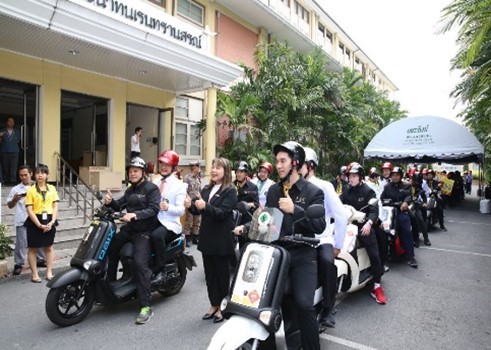The Integration of Health Promotion and Artificial Intelligence to Helmet Wearing Behavior Modification
Main Article Content
Abstract
Siriraj Hospital is a public medical institution offering health care service for university staff, students and also the general public. Increasing volume of traffic in the hospital area leads to traffic control and safety problems, especially from motorcycles. To response to these problems, Siriraj Health Promotion Division has introduced “We Care We Save” campaign since 2019 to prevent the risks of traffic accidents caused by riding motorcycles without safety helmets in the hospital area. The main purposes of this campaign are to promote traffic safety protocols and to facilitate the drivers to recognize the benefits of wearing safety helmets. To strive for an accident-free environment, this article demonstrated the five core components of health promotion model according to the First International Conference on Health Promotion held in Ottawa: building of healthy policy, creation of supportive environments for health, strengthening of community actions for health, development of personal skills, and reorientation of health services. Furthermore, artificial intelligence (AI) was used as one of the effective tools to track changes in helmet use behavior. The result of this study represented the important data analysis that could be used for improving safety helmet wearing behavior. Finally, the result from this study is allowed for modification and use according to various contexts from all of interested personnel.
Article Details

This work is licensed under a Creative Commons Attribution-NonCommercial-NoDerivatives 4.0 International License.
References
สำนักงานคณะกรรมการกฤษฎีกา. พระราชบัญญัติจราจรทางบก พ.ศ. ๒๕๒๒ [อินเทอร์เน็ต]. [เข้าถึงเมื่อ 5 พ.ย. 2563]. เข้าถึงได้จาก: http://web.krisdika.go.th/data/law/law2/%A803/%A803-20-9999- update.pdf
อาภาพร เผ่าวัฒนา และคณะ. (2554). การสร้างเสริมสุขภาพและป้องกันโรคในชุมชน: การประยุกต์แนวคิดและทฤษฎีสู่การปฏิบัติ. พิมพ์ครั้งที่ 1 กรุงเทพฯ: คณะสาธารณสุขศาสตร์ มหาวิทยาลัยมหิดล
AUN-Health Promotion Network. AUN Healthy University Framework [Internet]. 2017 [cited 2022 Jun 3]. Available from: https://aihd.mahidol.ac.th/aunhpn/AUN-PROJECT/pdf/Healthy%20University%20Framework%20Final.pdf
Baker, D.W., Wolf, M.S., Feinglass, J., Thompson, J.A. and Gazmararian, J.A., (2007). Health Literacy and Mortality among Elderly Persons. Arach Intern Med. 167(14). Berkman ND, Davis TC and Mccormack L. (2010). Health literacy: What is it. J Health Commun.;15:9-19.
Lin, H., Deng, J.D., Albers, D. and Siebert, F.W. (2020). Helmet Use Detection of Tracked Motorcycles Using CNN-Based Multi-Task Learning. IEEE Access 8: 162073-162084.
Rawassizadeh, R., Momeni, E., Dobbins, C. and Gharibshah, J. (2016). Scalable Daily Human Behavioral Pattern Mining from Multivariate Temporal Data. IEEE Transactions on Knowledge and Data Engineering 28(11): 3098-3112.
Siebert, F. W., Albers, D., Naing, U.A., Perego, P. and Santikarn, C. (2019). Patterns of motorcycle helmet use – A naturalistic observation study in Myanmar. Accid Anal Prev 124: 146-150.
Siebert, F. W. and Lin, H. (2020). Detecting motorcycle helmet use with deep learning. Accid Anal Prev 134:105319.
Wang, H., Hu, Z., Guo, Y., Yang, Z., Zhou, F. and Xu, P. (2020). A Real-Time Safety Helmet Wearing Detection Approach Based on CSYOLOv3. Applied Sciences 10(19).
World Health Organization. (1986). Ottawa Charter for Health Promotion. 1,4: p 2






